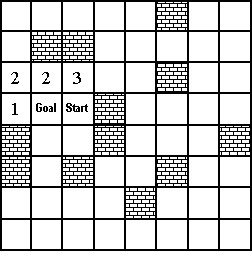I created this maze recently for the World Puzzle Championship. It was one of eighteen puzzles in an on-line qualifying exam used to pick the American team. That team will compete in the Championship to be held in Budapest in October, 1999. Will Shortz and Nick Baxter, who put together the exam, asked me to create a maze with a new layout, but with the same rules as one in my book SuperMazes.
Mazes with a single rolling die are now generally referred to as rolling-cube mazes, and they are pretty much an invention of mine. SuperMazes had four of them and even had a section called How to Create Your Own Rolling-Cube Mazes. That section turned out to be very popular. In John McCallion’s review of the book, he included a simple rolling-cube maze of his own creation. John’s maze wasn’t supposed to be especially challenging; he just wanted to show that it is possible to create these mazes.
Others have taken this concept of rolling cubes way beyond anything I had envisioned. Ed Pegg, Jr. created a maze that uses a cube with arrows on its faces. This cube rolls over a grid of arrows. To see his maze, go to Ed’s web site, www.mathpuzzle.com (which, incidentally, is the best puzzle site on the Internet), scroll down to “My Math Puzzle Pages,” then click on “Multistate Mazes.”
The greatest advance in this peculiar form of puzzle was made by Richard Tucker. He is a British software developer and puzzle designer. One of his creations is the 3D puzzle “King’s Court,” published by Pentangle.
Instead of a cube, Tucker uses two dice taped together! The dice form an elongated block that traces weird paths across the page. Instead of rolling, it looks more like it’s flopping around. It sounds like it should never work, but it does. The maze is easy to understand, though finding the solution can be hard.


 At the left is a small illustration of the maze. The numbers in the illustration are only for the example given below. Those numbers don’t appear in the full-size diagram of the maze.
At the left is a small illustration of the maze. The numbers in the illustration are only for the example given below. Those numbers don’t appear in the full-size diagram of the maze.